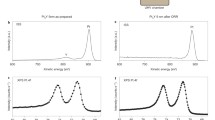Abstract
Catalytic converters are widely used to reduce the amounts of nitrogen oxides, carbon monoxide and unburned hydrocarbons in automotive emissions. The catalysts are finely divided precious-metal particles dispersed on a solid support. During vehicle use, the converter is exposed to heat, which causes the metal particles to agglomerate and grow, and their overall surface area to decrease. As a result, catalyst activity deteriorates. The problem has been exacerbated in recent years by the trend to install catalytic converters closer to the engine, which ensures immediate activation of the catalyst on engine start-up, but also places demanding requirements on the catalyst's heat resistance. Conventional catalyst systems thus incorporate a sufficient excess of precious metal to guarantee continuous catalytic activity for vehicle use over 50,000 miles (80,000 km). Here we use X-ray diffraction and absorption to show that LaFe0.57Co0.38Pd0.05O3, one of the perovskite-based catalysts investigated1,2,3,4 for catalytic converter applications since the early 1970s, retains its high metal dispersion owing to structural responses to the fluctuations in exhaust-gas composition that occur in state-of-the-art petrol engines5. We find that as the catalyst is cycled between oxidative and reductive atmospheres typically encountered in exhaust gas, palladium (Pd) reversibly moves into and out of the perovskite lattice. This movement appears to suppress the growth of metallic Pd particles, and hence explains the retention of high catalyst activity during long-term use and ageing.



Similar content being viewed by others
References
Meadowcroft, D. B. Low-cost oxygen electrode material. Nature 226, 847–848 (1970)
Libby, W. F. Promising catalyst for auto exhaust. Science 171, 499–500 (1971)
Tanaka, H., Fujikawa, H. & Takahashi, I. Perovskite-Pd Three-Way Catalysts for Automotive Applications (SAE Paper 930251, Society of Automotive Engineers, Inc., Warrendale, Pennsylvania, 1993)
Tanaka, H., Fujikawa, H. & Takahashi, I. Excellent Oxygen Storage Capacity of Perovskite-Pd Three-Way Catalysts (SAE Paper 950256, Society of Automotive Engineers, Inc., Warrendale, Pennsylvania, 1995)
Heck, R. M. & Farrauto, R. J. Catalytic Air Pollution Control: Commercial Technology 94–102 (Van Nostrand Reinhold, New York, 1995)
Waltner, A. et al. Development of Close-Coupled Catalyst Systems for European Driving Conditions (SAE Paper 980663, Society of Automotive Engineers, Inc., Warrendale, Pennsylvania, 1998)
Materlik, G., Sparks, C. J. & Fischer, K. (eds) Resonant Anomalous X-Ray Scattering (North-Holland, Amsterdam, 1994)
Teo, B. K. EXAFS: Basic Principles and Data Analysis (Springer, Berlin, 1986)
Vosko, S. H., Wilk, L. & Nusair, M. Accurate spin-dependent electron liquid correlation energies for local spin density calculations: a critical analysis. Can. J. Phys. 58, 1200–1211 (1980)
Painter, G. S. Improved correlation corrections to the local-spin-density approximation. Phys. Rev. B 24, 4264–4270 (1981)
Watanabe, H. Magnetic properties of perovskites containing strontium. J. Phys. Soc. Jpn 12, 515–522 (1957)
Jonker, G. H. Semiconducting properties of lanthanum-cobalt oxide. Philips Res. Rep. 24, 1–14 (1969)
Tejuca, L., Fierro, J. L. G. & Tascon, J. M. D. in Advances in Catalysis (eds Eley, D. D., Pines, H. & Weisz, P. B.) Vol. 36, 237–328 (Academic, San Diego, 1989)
Shannon, R. D. Revised effective ionic radii and systematic studies of interatomic distances in halides and chalcogenides. Acta Crystallogr. A 32, 751–767 (1976)
Hansen, M. (ed.) Constitution of Binary Alloys (McGraw-Hill, New York, 1958)
Emsley, J. (ed.) The Elements (Clarendon, Oxford, 1994)
Tanaka, H., Takahashi, I., Kimura, M. & Sobukawa, H. in Science and Technology in Catalysts 1994 (eds Izumi, Y., Arai, H. & Iwamoto, M.) 457–460 (Kodansya-Elsevier, Tokyo, 1994)
Tanaka, H., Tan, I., Uenishi, M., Kimura, M. & Dohmae, K. in Topics in Catalysts (eds Kruse, N., Frennet, A. & Bastin, J.-M.) Vols 16/17, 63–70 (Kluwer Academic, New York, 2001)
Acknowledgements
We thank M. Misono and N. Mizuno for their advice on catalyst research.
Author information
Authors and Affiliations
Corresponding author
Ethics declarations
Competing interests
The authors declare that they have no competing financial interests.
Rights and permissions
About this article
Cite this article
Nishihata, Y., Mizuki, J., Akao, T. et al. Self-regeneration of a Pd-perovskite catalyst for automotive emissions control. Nature 418, 164–167 (2002). https://doi.org/10.1038/nature00893
Received:
Accepted:
Issue Date:
DOI: https://doi.org/10.1038/nature00893
- Springer Nature Limited
This article is cited by
-
Experimental study of long-term catalytic effect on hydrogen generation G value of water by gamma-ray irradiation and hydrogen diffusion analysis in Compacted Hulls and End-Piece waste
Journal of Radioanalytical and Nuclear Chemistry (2024)
-
H2O Promotion of CO Oxidation On Oxidized Pt/CeFeOx
Catalysis Letters (2024)
-
Adsorption and removal of ethidium bromide from aqueous solution using optimized biogenic catalytically active antibacterial palladium nanoparticles
Environmental Science and Pollution Research (2023)
-
Impact of Pd Incorporation Method in Stoichiometric and La-Deficient LaxMnO3 on Catalytic Performances in Methane Combustion: A Step Forward the Development of Novel NGV Three-Way Catalysts
Topics in Catalysis (2023)
-
Palladium exsolution and dissolution with lanthanum ferrite perovskite oxides
Journal of Materials Science (2023)





